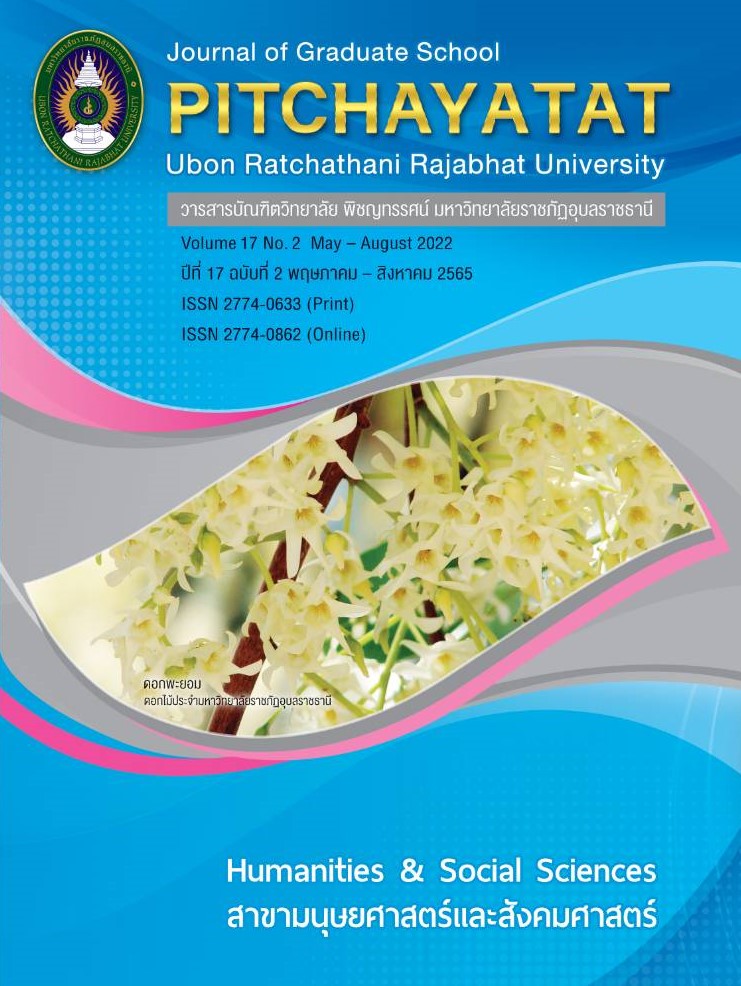การศึกษากลยุทธ์การเรียนรู้ภาษาอังกฤษของนักศึกษาสาขาวิชาภาษาอังกฤษ ชั้นปีที่ 4 คณะครุศาสตร์ มหาวิทยาลัยราชภัฏอุบลราชธานี
คำสำคัญ:
กลยุทธ์การเรียนรู้ภาษาอังกฤษ , นักศึกษาสาขาวิชาภาษาอังกฤษ , คณะครุศาสตร์บทคัดย่อ
การศึกษาครั้งนี้มีวัตถุประสงค์เพื่อศึกษาการใช้กลยุทธ์การเรียนรู้ภาษาอังกฤษของนักศึกษาสาขาวิชาภาษาอังกฤษ ชั้นปีที่ 4 คณะครุศาสตร์ มหาวิทยาลัยราชภัฏอุบลราชธานี และเพื่อเปรียบเทียบกลยุทธ์การเรียนรู้ภาษาอังกฤษของนักศึกษา จำแนกตาม เพศ ประสบการณ์การเรียนรู้ภาษาอังกฤษในต่างประเทศ และระดับความสามารถทางภาษาอังกฤษ เป็นงานวิจัยเชิงปริมาณ ตัวอย่าง คือ นักศึกษาหลักสูตรครุศาสตรบัณฑิต สาขาวิชาภาษาอังกฤษ ชั้นปีที่ 4 คณะครุศาสตร์ มหาวิทยาลัยราชภัฏอุบลราชธานี ภาคเรียนที่ 2 ปีการศึกษา 2562 จำนวนทั้งหมด 61 คน เครื่องมือที่ใช้ คือ แบบสอบถามดัดแปลงมาจาก Oxford Strategies Inventory for Language Learning (SILL) version 7.0 for ESL/EFL สถิติที่ใช้ ได้แก่ ค่าเฉลี่ย ร้อยละ ส่วนเบี่ยงเบนมาตรฐาน การทดสอบที การวิเคราะห์ความแปรปรวนทางเดียว
ผลการศึกษาพบว่า
ภาพรวมการใช้กลยุทธ์การเรียนรู้ภาษาอังกฤษของนักศึกษา อยู่ในระดับปานกลาง โดยใช้กลยุทธ์ด้านที่นำไปสู่ความสำเร็จมากที่สุด และใช้กลยุทธ์การจำน้อยที่สุด นอกจากนี้ พบว่า นักศึกษาที่มีเพศ และประสบการณ์การเรียนรู้ภาษาอังกฤษในต่างประเทศแตกต่างกัน มีกลยุทธ์การเรียนรู้ภาษาอังกฤษโดยรวมแตกต่างกัน ในขณะที่นักศึกษาที่มีระดับความสามารถทางภาษาอังกฤษแตกต่างกัน มีกลยุทธ์การเรียนรู้ภาษาอังกฤษโดยรวมไม่แตกต่างกัน
เอกสารอ้างอิง
กลุ่มส่งเสริมการเรียนการสอนภาษา สถาบันภาษาอังกฤษ สํานักวิชาการและมาตรฐานการศึกษา. ความเป็นมา. (ออนไลน์) 2555 (อ้างเมื่อ 15 มกราคม 2563). จาก http://english.obec.go.th/english/2013/index. php/th2012-0808-06-25-22
คณะกรรมการการอุดมศึกษา. ประกาศสำนักงานคณะกรรมการอุดมศึกษา กระทรวงศึกษาธิการ เรื่องการคัดเลือกเข้าร่วมโครงการผลิตครูเพื่อพัฒนาท้องถิ่น ปี พ.ศ. 2561. กรุงเทพฯ: กระทรวงศึกษาธิการ, 2560.
บุญใจ ศรีสถิตนรากูร. การพัฒนาและตรวจสอบคุณภาพเครื่องมือวิจัย: คุณสมบัติการวัดเชิงจิตวิทยา. กรุงเทพฯ: โรงพิมพ์แห่งจุฬาลงกรณ์มหาวิทยาลัย, 2555.
ปิยนุช อุดมเกียรติสกุล. กลวิธีการเรียนรู้ภาษาอังกฤษที่มีผลต่อทักษะภาษาอังกฤษของนักเรียน มัธยมศึกษาตอนปลายแผนการเรียนสายศิลป์ โรงเรียนเอกชน จังหวัดปทุมธานี. การประชุมวิชาการและเสนอผลงานวิจัยระดับชาติ ก้าวสู่ทศวรรษที่ 2 : บูรณาการงานวิจัยใช้องค์ความรู้ สู่ความยั่งยืน ครั้งที่ 3 มิถุนายน 2559. หน้า 854-858. นครราชสีมา : วิทยาลัยนครราชสีมา, 2559.
วิชาการและมาตรฐานการศึกษา, สำนัก. ตัวชี้วัดและสาระการเรียนรู้ภาษาต่างประเทศ (ภาษาอังกฤษ) ตามหลักสูตรแกนกลางการศึกษาขั้นพื้นฐานพุทธศักราช 2551. กรุงเทพฯ: ชุมนุมสหกรณ์การเกษตรแห่งประเทศไทย, 2552.
ศิวนนท์ นิลพาณิชย์. “กลยุทธ์การเรียนรู้ภาษาอังกฤษของนักศึกษามหาวิทยาลัยชั้นปีที่ 1,” วไลยอลงกรณ์ปริทัศน์ (มนุษยศาสตร์และสังคมศาสตร์). 7, 2 (พฤษภาคม-สิงหาคม 2560): 1-12.
สุชาติ หินมะลิ. “การศึกษาการใช้กลยุทธ์การเรียนภาษาอังกฤษของนักศึกษามหาวิทยาลัยเชียงใหม่ชั้นปที่ 1 และชั้นปีที่ 3,” ศึกษาศาสตร์ มหาวิทยาลัยศิลปากร. 12, 1, 2 (มิถุนายน 2557-มีนาคม 2558): 95-105.
สุรีย์ จงสถาพรสิทธิ์. การศึกษาวิธีการเรียนวิชาภาษาอังกฤษของนักเรียน ชั้นมัธยมศึกษาปีที่ 5 ในโรงเรียนสังกัดกรมสามัญศึกษา กรุงเทพมหานคร. กรุงเทพฯ: จุฬาลงกรณ์มหาวิทยาลัย, 2543.
ส่งเสริมวิชาการและงานทะเบียน มหาวิทยาลัยราชภัฏอุบลราชธานี, สำนัก. (2562). ข้อมูลสถิตินักศึกษาประจำปี 2562. (ออนไลน์) 2562 (อ้างเมื่อ 15 มีนาคม 2563). จาก: http://www.apr.ubru.ac.th/index.php/
อนุ ยอดพรหมมินทร์ และคณะ. กลวิธีการเรียนภาษาอังกฤษของนักศึกษาสาขาวิชาภาษาอังกฤษ มหาวิทยาลัยราชภัฏบุรีรัมย์. (ออนไลน์) 2549 (อ้างเมื่อ 10 มกราคม 2563). จาก: https://dspace.bru.ac.th
Bialystok, E. “The role of conscious Strategies in second language proficiency,” Modern Language Journal. 65 (1981): 24-35.
Brosh, H. “Language-Learning Strategy Preferences among College-Level Language Students,” Applied Language Learning. 28, 1 (2018): 19-40.
Ellis, R. “Principles of instructed language learning,” System. 33, 2 (2005): 208-224.
Ellis, R. The Study of Second Language Acquisition. 2nd ed. Oxford: Oxford University Press, 2008.
Green, J. M. and R. Oxford. “A closer look at learning strategies, L2 proficiency, and gender,” TESOL QUARTERLY. 29, 2 (1995): 261-297.
Kunasaraphan, K. “English learning strategy and proficiency level of the first year students,” Proceeding–Social and Behavioral Sciences. 197 (2015): 1853-1858.
Oxford, R. L. Language Learning Strategies; What Every Teachers Should Know. New York: Harper & Row, 1990.
Santikarn, B. “The use of language learning strategies: A case study of undergraduate students in a private university,” Journal of Language and Communication. 19, 21 (2014): 55-72.
Wong, M. S. Language Learning Strategy Use: A Study of Pre-Service Teachers in Malaysia. (online) 2011 (cited 15 September 2019). Available from https://eric.ed.gov/?q=mary+ siew+ lian+wong&id=ED521415
Zhou, C. and C. Intaraprasert. Language Learning Strategies Employed by Chinese English-Major Pre-Service Teachers in Relation to Gender and Personality Types. (online) 2015 (cited 22 December 2018). Available from http://dx.doi.org/10.5539/elt.v8n1p155
ดาวน์โหลด
เผยแพร่แล้ว
รูปแบบการอ้างอิง
ฉบับ
ประเภทบทความ
สัญญาอนุญาต
ลิขสิทธิ์ (c) 2022 วารสารบัณฑิตวิทยาลัย พิชญทรรศน์ มหาวิทยาลัยราชภัฏอุบลราชธานี

อนุญาตภายใต้เงื่อนไข Creative Commons Attribution-NonCommercial-NoDerivatives 4.0 International License.
บทความทุกเรื่องได้รับการตรวจความถูกต้องทางวิชาการโดยผู้ทรงคุณวุฒิภายนอกอย่างน้อย 2 คน ความคิดเห็นในวารสารบัณฑิตวิทยาลัย พิชญทรรศน์ มหาวิทยาลัยราชภัฏอุบลราชธานี เป็นความคิดเห็นของผู้เขียนมิใช่ความคิดเห็นของผู้จัดทำ จึงมิใช่ ความรับผิดชอบของบัณฑิตวิทยาลัย มหาวิทยาลัยราชภัฏอุบลราชธานี และบทความในวารสารบัณฑิตวิทยาลัย พิชญทรรศน์ มหาวิทยาลัยราชภัฏอุบลราชธานี สงวนสิทธิ์ตามกฎหมายไทย การจะนำไปเผยแพร่ต้องได้รับอนุญาตเป็นลายลักษณ์อักษรจากกองบรรณาธิการ






